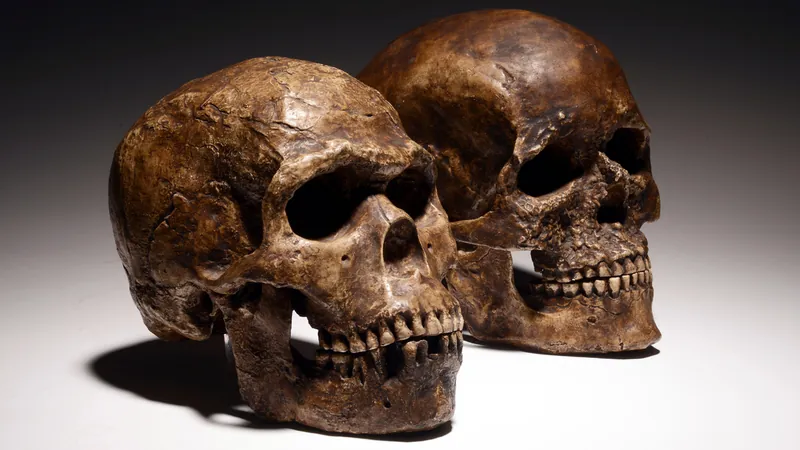
How Neanderthals' Unique Blood Type May Hold the Key to Their Extinction
2025-01-23
Author: Ling
Abstract
In a groundbreaking study, researchers have suggested that a rare blood type in Neanderthals could be a significant factor in their extinction coinciding with the rise of modern humans. The findings, recently published in the journal Scientific Reports, indicate that Neanderthals' blood groups, particularly their unusual Rh factor, may have been detrimental to their newborns, exacerbating their struggle for survival as Homo sapiens migrated out of Africa.
Human Blood Classification System
The human blood classification system, which many recognize as the ABO blood typing system (A, B, AB, O), is driven by proteins and sugars known as antigens on red blood cells. These antigens play a critical role in immune recognition. If, for example, a person with type A blood is exposed to type B blood, their immune system will mount an attack due to the foreign antigens. This immune reaction underscores the importance of blood type compatibility, especially in medical procedures like blood transfusions.
Research Findings
To understand the evolutionary trajectory of our closest ancient relatives, a team from Aix-Marseille University undertook an extensive analysis of ancient genomes, focusing on individuals who lived between 120,000 and 20,000 years ago. Their investigation revealed that Neanderthals possessed a variant of the Rh factor, which is exceedingly rare in contemporary human populations. This specific RhD variant was incompatible with the blood types of early Homo sapiens and Denisovans.
Implications of Rh Incompatibility
Dr. Stéphane Mazières, the lead author of the study, explained the implications of this research: "In instances of interbreeding between Neanderthal females and Homo sapiens or Denisovans, there would be a heightened risk of hemolytic disease in newborns. This serious condition can cause complications like jaundice, severe anemia, neurological damage, and even death."
Lack of Medical Interventions
The physiological implications of Rh incompatibility can be grave, especially given the absence of modern medical interventions. Today, Rh incompatibility is managed with prenatal immunoglobulin therapy, which prevents the immune system of an Rh-negative individual from attacking an Rh-positive fetus. However, such medical techniques were not available thousands of years ago, posing a dire challenge to pregnant Neanderthal women.
Evolution of Rh Gene Variants
Importantly, the research traced the evolution of the Rh gene variants prevalent in many modern humans back to early Homo sapiens ancestors who likely developed these traits shortly after leaving Africa. Contrastingly, Neanderthals exhibited little change in their Rh variants over the last 80,000 years, indicating a form of stagnation due to their relatively isolated existence.
Conclusion and Future Research
While the study provides insights into the potential link between Neanderthal blood types and their extinction, it also raises intriguing questions about the evolutionary advantages of red blood cell diversity seen in modern humans. Dr. Mazières speculated that population expansions and adaptations to novel environments in Eurasia could have spurred this variation over a period of at least 15,000 years.
This research not only sheds light on the fateful challenges faced by Neanderthals but also highlights a complex interrelation between genetics and survival. As scientists continue to decode the mysteries surrounding our ancient relatives, each finding takes us a step closer to understanding the dynamics of human evolution and the ultimate fate of the Neanderthal lineage.



 Brasil (PT)
Brasil (PT)
 Canada (EN)
Canada (EN)
 Chile (ES)
Chile (ES)
 Česko (CS)
Česko (CS)
 대한민국 (KO)
대한민국 (KO)
 España (ES)
España (ES)
 France (FR)
France (FR)
 Hong Kong (EN)
Hong Kong (EN)
 Italia (IT)
Italia (IT)
 日本 (JA)
日本 (JA)
 Magyarország (HU)
Magyarország (HU)
 Norge (NO)
Norge (NO)
 Polska (PL)
Polska (PL)
 Schweiz (DE)
Schweiz (DE)
 Singapore (EN)
Singapore (EN)
 Sverige (SV)
Sverige (SV)
 Suomi (FI)
Suomi (FI)
 Türkiye (TR)
Türkiye (TR)
 الإمارات العربية المتحدة (AR)
الإمارات العربية المتحدة (AR)